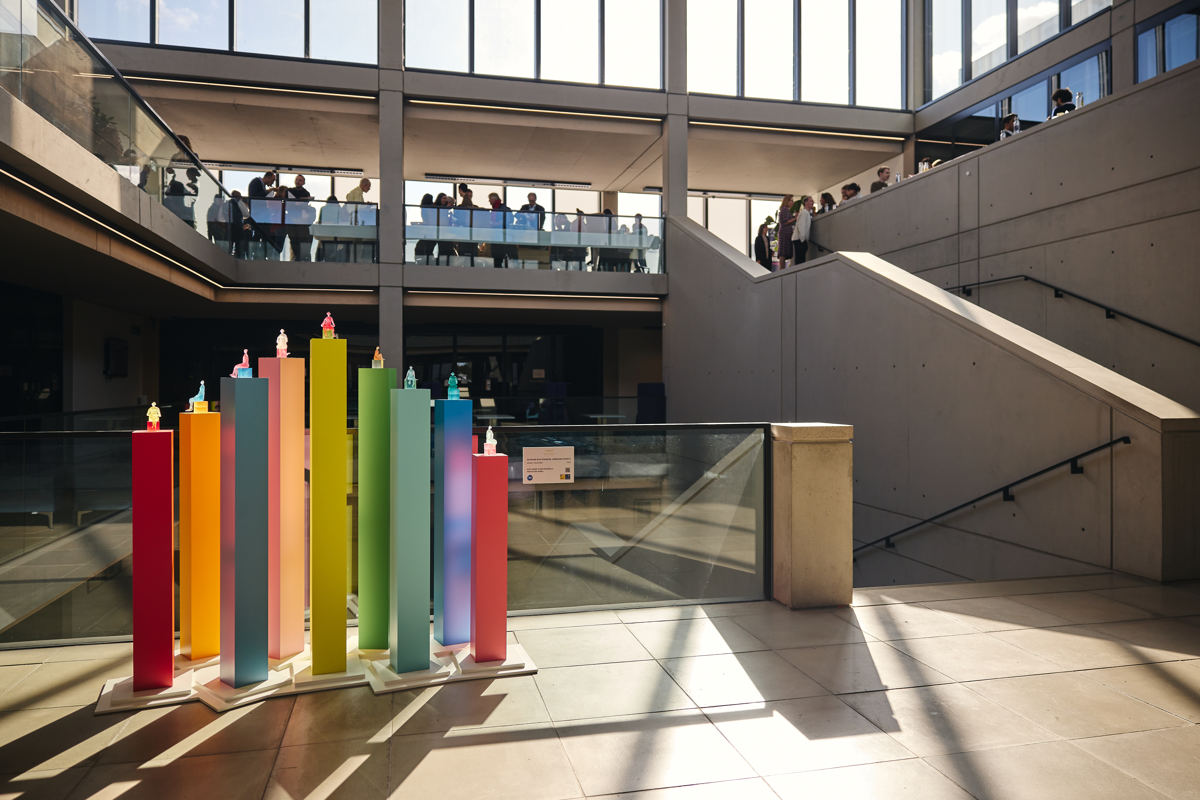A small selection of her most recent works
following her recent AXA art prize UK at the Royal Academy, Summer Exhibition, 2024
SQFT: Space Gallery, 95 Bell Street, London NW1 6TL
Thursday 5th December 2024
to Friday 10th January 2025
Open weekdays 10:00 am – 6:00pm
outside these hours by appointment please contact:
[email protected]
or
[email protected]
Private view
4th December 2024
5pm -9pm


Wendy’s idea for this specially commissioned sculpture emerged from the intimate ambiance of the theatre, where individuals gather in dim light, surrounded by strangers, each with their own identities, their own genetic make-up. This sculpture embodies the profound experience of shared presence, where differences, whether visible or invisible, dissolve into the collective embrace of the moment – the connection, the being, overrides all.
Wendy explains “At the outset of this project for Oxford University, I experienced the unfortunate event of fracturing my ankle, which led to spending the summer in a wheelchair. This challenging situation opened my eyes to a different perspective, allowing me to understand the difficulties faced by others who have limited mobility and cannot easily view objects of interest. It turned out to be a fortunate accident, aligning this perfectly with the essence and intentions of my project, creating a more accessible visual experience for all – the initial height for the lowest plinth being the same as my eye height whilst seated in a wheelchair”.
Wendy’s considered use of colour within this sculpture is key – the delicious desirability of the translucent shades of the figures are reminiscent of boiled sweets, evoking happy childhood memories. Everyone loves boiled sweets, everyone is unique and everyone is beautiful.
The selected complementary colour hues do not carry any specific symbolic, social or gendered meanings. Instead, they aim to embrace all ideologies and beliefs that are also reflected in the Department of Economics logo suggesting themes of equality, diversity, and inclusion.
The carefully considered composition of the sculpture also echoes the ethos of The Department of Economics commitment to inclusion – the figures linking to one another by their positioning within the group – not turning their backs to anyone looking in, allowing the viewer to feel included, like they too could join the seated group.
PROJECT SPONSORS

‘The Quietest Moments’, oil on canvas (120cm x 150cm) – we are please to announce has be selected to be be part of this years Royal Academy Summer Exhibition 2024. (item 2 on the catalogue)
The Exhibition Opens 18th June and runs to 18th August and is widely reported to be the worlds largest open submission exhibition in the world, featuring work in every medium imaginable.
Tickets click here (Opening hours: Monday Closed, Tuesdays – Sundays 10:00am – 6pm, Friday 10:00am – 9:00pm)
We are delighted to announce the ‘The Sad’, oil on canvas (75cm x 89cm x 2.5cm), has be selected to be be part of this years Royal Academy Summer Exhibition.
The Exhibition Opens 13th June and runs to 20th August and is reported to be the worlds largest open submission exhibition featuring work in every medium imaginable. Tickets click here

Mall Galleries London
November 2022 (dates to be advised)
The Covid-19 Lockdown has had a profound effect all of us all. Its like some fictional novel – totally unbelievable… only sadly, its really happening… a real nightmare!
With the foundry being shut my normal working practices have had to change, These portraits represent what started as a daily challenge, they have become almost routine now, initially just to stay ‘semi-sane’ it’s now something I actually look forward to everyday. Having published a few examples on my Instagram account – @wendyfreestone (and other social media channels), I had a number of People asked me ‘where can i buy these?’ it seemed the obvious choice to add a few to the web site.
Art enthusiast might also be interested to know
I have been donating (postcard size versions) to a weekly ‘feed the NHS charity art sale‘
Grapheme-color synesthesia or coloured grapheme synesthesia is a form of synesthesia in which an individual’s perception of numerals and letters is associated with the experience of colours. Like all forms of synesthesia, Grapheme-color synesthesia is involuntary, consistent, and memorable.
It is on this basies I have created and experimented with my own colour alphabet.
Using the colour key on the other side of this sheet you will be able to decipher hidden words in my coloured series.
I was honoured to be the “Visitor’s Choice Artist” at this years Royal Arts Price and to be awarded a two-week joint exhibition at one of their London galleries.
UK Youth is a leading national charity, founded in 1911, that delivers non-formal education opportunities for young people aged 9-25 across the length and breadth of the country.
Our mission is to work hand in hand with young people – and the dedicated organisations supporting them – to develop the skills, belief, courage and leadership to build a bright future.
Through our network of youth organisations across the country, we reach and impact on more than 830,500 young people every year. Of these, 55,000 participate in UK Youth apprenticeships, accreditations, our life-changing programmes and outdoor education at Avon Tyrrell in the New Forest.
 I believe the family unit is quite possibly the most important thing in our lives, In appreciation of this I have developed this site to make it simple for you to create your own ’completely unique’ contemporary bronze sculpture representing your family.
I believe the family unit is quite possibly the most important thing in our lives, In appreciation of this I have developed this site to make it simple for you to create your own ’completely unique’ contemporary bronze sculpture representing your family.
Select the individual family members from the lists below, choose to solder them together or leave them freestanding.
You can even include your family dog or cat if you wish. (other pets can be created specially contact me directly to discuss)
Unless specified the artist will assemble the figures in the order she feels suits the family group.
Depending on stock levels delivery time could be 2-3 weeks.
‘Watching’
The work explores themes of diaspora, community, and sense of belonging. The anonymity of the crowd with their broad spectrum of acceptance and tolerance share the underlying fear of difference with the individual being met with suspicion. The solitary figure, separated not only through distance but in its ostensibly different material of gold plating in fact conceals the very same material of the onlookers.
 Figurative female with her arms up
Figurative female with her arms up
designed to catch water for the birds
Very pleased with this recently installed commission, so I thought I would share the experience and processes (in summary).
Working closely with a client and garden designer Mary Bullock, I created a smaller scale model (often referred to as a maquette) for client comment/approval.
Once approved, a carefully replicated full size version of the model was created in a material similar to polystyrene and wax – This figure was then signed off by the client and declared ‘ready for casting’.
Having completed the casting process, a considerable amount of time was spent finishing and achieving the desired patina. Back on site – A special base had been prepared to take her ‘now’, quite considerable weight.
Install was a relatively painless and relaxed affair but did involve two installers from the foundry and a number of ‘volunteer’ husbands drafted in as additional muscle. As I said earlier she is exceptionally heavy.
Now firmly in place – she will only improve with time.
If you wish to discuss a similar project or just an idea, please get in touch.
Lost-wax casting (also called “investment casting“, “precision casting”, or cire perdue in French) is the process by which a duplicate metal sculpture (often silver, gold, brass or bronze) is castfrom an original wax sculpture in my case.
The process is quite long winded, here how wikipedia explain it!
Casts can be made of the wax model itself, the direct method, or of a wax copy of a model that need not be of wax, the indirect method. These are the steps for the indirect process: